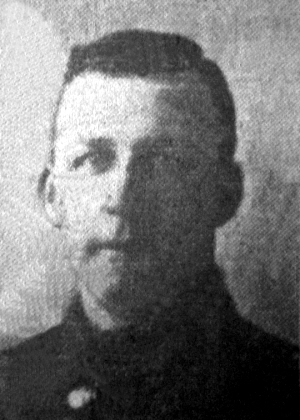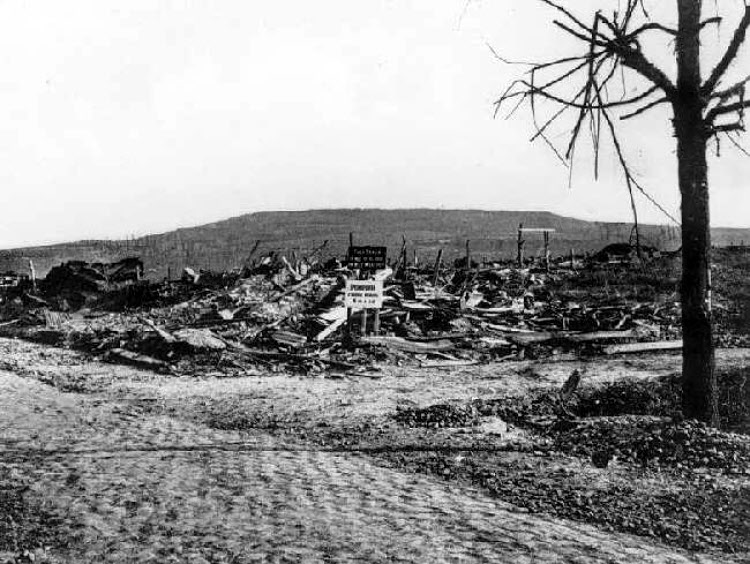
George Henry Oldroyd was born on the 11th February 1879 and was baptised on the 25th March 1879 at the Primitive Methodist Church, Ossett. He was the eldest son of four sons born to Henry Oldroyd and his wife, Martha (nee Fawcett), who were married in late 1877. All of Henry and Martha’s sons enlisted in the army during WW1.
In 1881 George Henry Oldroyd was aged two years and was a boarder in the Dale Street, Ossett home of his aunt, Alice Dews. His younger brother was born around this time. In 1891 George Henry was living with his parents, three brothers, grandmother and aunt Alice at Dale Street, Ossett. His father, Henry Oldroyd was working as a coal miner, but by 1901, Henry was working as a rent and debt collector. Henry Oldroyd, wife Martha and their four sons were living on Bank Street, Ossett. George Henry, now aged 22, was working as a coal miner.
In the summer of 1902, George Henry Oldroyd married Emma Brook in Ossett, and they went on to have three sons: James, Walter and Fred, born in 1904,1905 and 1908 respectively. All of the family were born in Ossett, except for Fred Oldroyd, who was born in Burton on Trent. In 1911, George Henry, an insurance agent, and his wife Emma and three sons born were living in South Crosland, near Honley, Huddersfield.
George Henry Oldroyd’s service record has not survived, but it is known that he enlisted at Ossett and joined the King’s Own Yorkshire Light Infantry Regiment with service number 205323. He was killed in action on the 25th April 1918 when his next-of-kin were recorded as his parents Mr. and Mrs. H. Oldroyd of 6, Marlborough Street, Ossett and his widow Mrs. E. Oldroyd of 3, Headlands Road, Ossett. George Henry was posthumously awarded the British and Victory medals, but not the 1914/15 Star, indicating that he had not served overseas before the 31st December 1915.
The 9th Battalion, of the Kings Own Yorkshire Light Infantry was raised at Pontefract in September 1914 as part of Kitchener’s Third New Army and joined 64th Brigade, 21st Division. After initial training, close to home, they moved to Berkhamsted and then on to Halton Park in October. They spent the winter in billets in Maidenhead from November and returned to Halton Park in April 1915. They moved to Witley for final training in August and proceeded to France in September 1915.
They marched across France and went straight into action in reserve of the British assault at Loos on the 26th of September 1915, suffering heavy casualties. In 1916 they were in action in the Battles of The Somme, including The Battle of Morval in which the Division captured Geudecourt. In 1917 they were in action during The German retreat to the Hindenburg Line, the Arras offensive, the Third Battles of Ypres and The Cambrai Operations. In 1918 they fought on the Somme then moved north and were in action during the Battles of the Lys, the Battle of the Aisne, the Somme, the Battles of the Hindenburg Line and the Final Advance in Picardy. At the Armistice the Division were around Berlaimont, on the 12th they moved to Beaufort, then in mid-December 1918, they moved west of Amiens and demobilisation began being completed by the 19th of May 1919.
On April 25th and 26th 1918, the 21st Division was involved in a ferocious battle, the 2nd Battle of Kemmel (or the Kemmelberg), part of the Battle of the Lys, in order to prevent a German attack getting round behind Ypres from the South. An attack was organised for the 25th April with the objective of taking the Vierstraat Line. 9th KOYLI were acting as part of this attack, which was a joint French and British action. Signaller George Henry Oldroyd was killed during this battle.
“At 02:30 hours on the 25 April 1918 over 250 batteries of German guns opened up on Allied artillery positions with a mixture of gas and high explosive. For the next two hours they concentrated solely on destroying gun emplacements. After a short pause, at 05:00 hours, the German barrage was switched to the French front line. French soldiers who had survived the horrors of Verdun described it as the worst they had ever encountered. Opposite a single French Division were amassed three and a half German Divisions. An hour of such a furious bombardment was considered sufficient by the Germans and at 06:00 hours they launched their infantry to the attack. By 07:10 hours Kemmel Hill was theirs and by 10:30 hours it was all over. Even the German airforce had joined in with 96 aircraft dropping 700 bombs and machine gunning the French positions as the Leib Regiment of the élite Alpine Corps (in fact a Division) stormed forward.
Two battalions of the French 99th RI together with the remnants of those who had escaped from Mont Kemmel held the line assisted by units from their dismounted 3rd Cavalry Division. On the southern flank of the 28th Division the 154th had been forced to give way towards Loker but their line was basically holding, as was that of the British on the northern. A gap however developed between the struggling 99th RI and the 9th Bn KOYLI and 6th Bn KOSB who were immediately alongside them. To this end the 147th British Brigade was brought up from Poperinge to plug the gap. Pressure from the Germans continued and by midday Vierstraat had fallen, but by now the attackers were also tired. That evening the British 25th Division arrived at Reningelst and were placed under French command to attempt with the French 39th Division to seize back Kemmel.” 1
The “Ossett Observer” 2 had this obituary for George Henry Oldroyd:
“Ossett Accountant Killed By A Shell – Another well-known and respected Ossett man, Signaller George Henry Oldroyd (39), King’s Own Yorkshire Light Infantry, has given his life in the country’s service. The eldest son of Mr. Henry Oldroyd, accountant and debt-collector, deceased a few years ago took over his father’s business in Dearden-street, Ossett. He leaves a widow and three children. It is about twelve months since the deceased joined the army, and after qualifying for efficiency in marksmanship, ambulance work and signalling, he went to the western battle-front on Easter Day – the same day that his brother Herbert returned to England wounded.
According to a letter received from a comrade Signaller Oldroyd was instantly killed by a shell one day last week, and his friends of the cyclist section have forwarded their sympathy. The writer of the letter says that during the short time that they had known him, they had learned to respect him for his cheerful countenance and his willingness to perform any duty allotted to him.
Deceased had practically a life-long connection with the Queen-street Primitive Methodist Church and School, where he was a Sunday school teacher and member of the choir.
Of his brothers, Herbert is in hospital in this country, recovering from a compound fracture of both ankles, received in the war. Alonzo has been discharged from the army on account of his injuries received during operations at Salonika; and Percy, after a short experience of army life, has been discharged as unfit for army service.”

Above: Kemmel Hill in late 1918.
Private George Henry Oldroyd, aged 39 years, son of Mr. and Mrs. H. Oldroyd, of 6, Marlborough Street, Ossett; husband of Mrs. E. Oldroyd, of 3, Headlands Rd., Ossett, died on the 25th April 1918. He is remembered on Panels 108 to 111 on the Tyne Cot Memorial 3, West-Vlaanderen, Belgium. The Tyne Cot Memorial to the Missing forms the north-eastern boundary of Tyne Cot Cemetery, which is located 9 kilometres north east of Ieper town centre, on the Tynecotstraat, a road leading from the Zonnebeekseweg (N332).
The Tyne Cot Memorial is one of four memorials to the missing in Belgian Flanders which cover the area known as the Ypres Salient. Broadly speaking, the Salient stretched from Langemarck in the north to the northern edge in Ploegsteert Wood in the south, but it varied in area and shape throughout the war. The Tyne Cot Memorial now bears the names of almost 35,000 officers and men whose graves are not known.
References:
1. The Second Battle for Kemmel
2. “Ossett Observer”, 18th May 1918